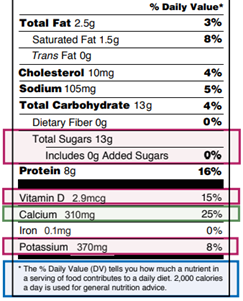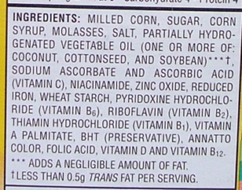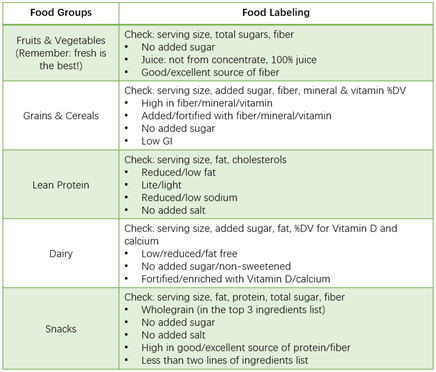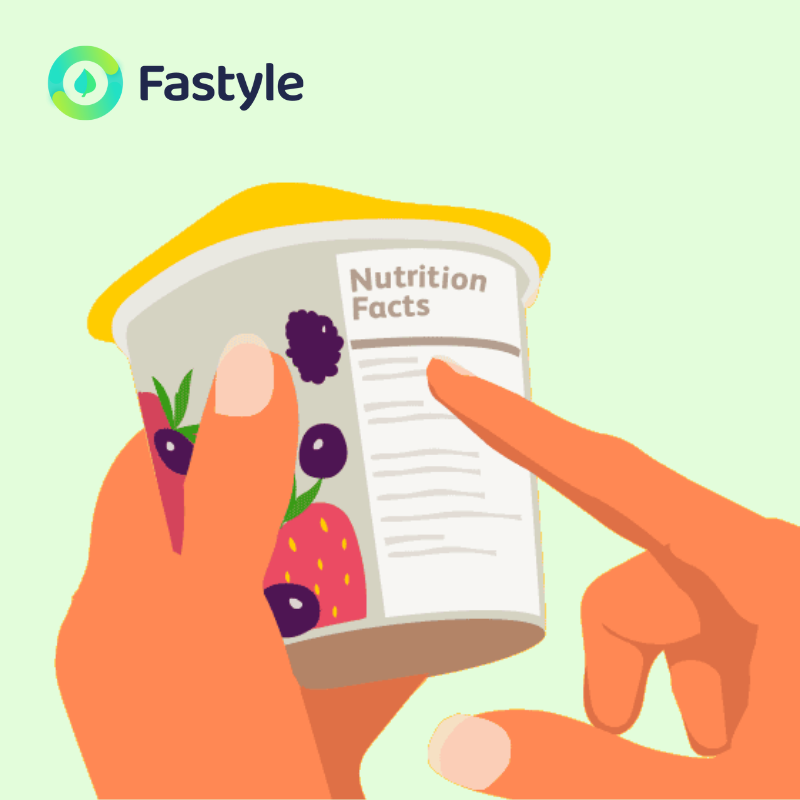Food labeling includes ingredients list, the Nutrition Facts label, and nutrition claims on products. Reading labels can be tricky as manufacturers use misleading tricks to convince people to buy their products. Understanding how to read food labels can be a great guide to help you choose foods for healthy eating. This article will talk you through the types of food labeling and what to look for to help you differentiate between mislabeled highly processed food and really healthy foods.
The Nutrition Facts label
The Nutrition Facts label on packaged food is based on food science and dietary recommendations. It is mandatory for all packaged food made and imported from most countries to have a Nutrition Fact label.
Here are a few key elements on the Nutrition Fact label you should know about:
Serving size
Usually, there will be a total serving for the whole package and a recommended serving size. For example, a container of low-fat milk covers 8 servings each of which is 1 cup (240ml). The former number indicates a total serving of the whole package while the latter indicates a recommended serving size, that is, 1 cup is recommended to be drunk each time.

Calories
The calories on the label represent the number of calories in 1 recommended serving. For example, if you eat 1 serving, you’ll get 100 calories from that serving size. Or sometimes there is a second column that displays the total calories for the whole package. Therefore, the per-unit should be focused on when calories are figured out before the food or drink is consumed.

% Daily Value
The % Daily Value (DV) tells you how much a nutrient in a serving of food contributes to a daily diet of 2,000 calories is used for general nutrition advice. It is a simple guide to use to assess nutrition value.
The data in this part of a nutrition label accounts for a majority and how to understand the data is quite important.

Total Fat
This shows you the types of fat in the food. There are usually two types of fats that are further specified in Total Fat, saturated fat and trans-fat. Generally speaking, both saturated fat (animal fat) and trans-fat (hydrogenated oil) are unhealthy fat, high consumption is led to an increased risk of cardiovascular diseases. When it comes to the specific amount of intake per serving, it’ll be accurately introduced in the latter part of the article below.
Total carbohydrate
This shows you the types of carbohydrates in the food, including sugar (total sugars & added sugars) and dietary fiber. Generally, the higher amount of dietary fiber a type of food contains, the better and the lower amount of sugar it contains, the better.
Cholesterol, sodium, protein, minerals, and vitamins
The amount of each nutrient in the food is also labeled. Only protein doesn’t have a % Daily Value.
After understanding what these values on the Nutrition Facts label mean, you can now start to check all your packaged food in the pantry or on your grocery shopping. Here is a quick guide on how to use all these values from the Nutrition Facts label.
Step 1: Start with the serving size.
- Check the total number of servings in the package and the recommended serving size.
- Compare your actual portion size to the recommended serving size listed on the panel.
- Many people are not aware about the serving size scheme, assuming a whole pack is a serving. In fact, it can be two or more serves in that package.
Step 2: Count calories.
- Check the total calories and the calories in a single serving.
- If you’re eating more than 1 recommended serving, you’re also getting more calories from your actual portion eaten. For example, 15 chips (28g) are 1 serve for a small pack of potato chips, and however, most don’t count and eat a whole pack of chips, which equals to 3 serves.
Step 3: Use %Daily Value (DV) as a guide for nutrients.
- You may need more or less than 2,000 calories per day depending on your age, gender, weight and muscle mass.
- Aim Low ( 5%) in saturated fat, cholesterol and sodium, avoid trans-fat.
- Aim for 10% in added sugar
- Aim high ( 20%) in vitamins, minerals and fiber.
Ingredient list
All food ingredients, addictive, and colors must be listed in the ingredient lists by weight in descending order, from the highest to lowest weight.
The first ingredient listed is what was used in the largest amount by weight (the main ingredient). A good and simple way to compare a packaged food is by checking its first three ingredients.
- If the top 3 ingredients include refine carbohydrate (added sugar), hydrogenated oils, saturated fat, salt or stocks are likely unhealthy.
- Instead, choose the food whose first ingredients have whole foods (non-processed food), such as fruits, vegetables, grains, meats…
- Choose products that has a ingredients list with less than two lines. More ingredients listed suggests the product is highly processed with more food additives.

Added sugar
Food manufacturers use added sugar by many different names to their products. The top ingredients may be healthier ingredients with a few different types of sugar further down the list to hide the actual amount of sugars added in the product. The leading types of sugar to be introduced below contribute to the added sugar category:
- Types of sugar: beet sugar, brown sugar, buttered sugar, cane sugar, caster sugar, coconut sugar, date sugar, golden sugar, invert sugar, muscovado sugar, organic raw sugar, raspadura sugar, evaporated cane juice, and confectioner’s sugar.
- Types of syrup: carob syrup, golden syrup, high-fructose corn syrup, honey, agave nectar, malt syrup, maple syrup, oat syrup, rice bran syrup, and rice syrup.
- Other added sugars: barley malt, molasses, cane juice crystals, lactose, corn sweetener, crystalline fructose, dextran, malt powder, ethyl maltol, fructose, fruit juice concentrate, galactose, glucose, disaccharides, maltodextrin, and maltose.
Nutrition Term
Nutrition terms are claims made by the manufacturer to highlight product features. Some claims are a good guide to identify the nutrient value of the product, while some are misleading claims made by the manufacturers to increase sales.
Here are some of the most common claims — and what they mean:
- Low calorie: 40 calories per serving.
- Calorie free: 5 calories per serving.
- Light/reduced. At least 25% less of the specified nutrient or calories than the usual product.
These are good indications for lower or very calorie products, but you should still look at the serving size and compare it to your actual portion to avoid a serving size scheme. Some products are simply watered down or reduced in serving size to reach the claim. There are also foods that are naturally low in calories or don’t have any such as flavored water, some diet soft drinks, etc.
- Good source of: Provides at least 10 to 19% of the Daily Value of a particular vitamin or nutrient per serving.
- Excellent source of/high in: Provides at least 20% of the %Daily Value of a particular vitamin or nutrient per serving.
Both the above are good indicators when you’re looking for specific nutrients or fortified products. However, being a good/excellent source doesn’t mean it is healthy straight away.
For example, breakfast cereals are fortified with added vitamins and minerals with higher %DV. But you should still look at the labels, whether they are added with a large amount of sugar.
- Fat free/sugar free: 0.5g of fat or sugar per serving.
- Low/reduced fat: at least 25% less in fat than the usual product.
This can be tricky when most products on the market are likely to have reduced or fat-free marketed at the cost of adding more sugar. Same logic when labeled low or sugar-free with added fat. So be very careful and read the ingredients list.
- Low carb. Similar to “low-fat”, read ingredients list carefully.
- Low cholesterol: 20mg of cholesterol and 2g of saturated fat per serving.
- Low sodium: 140mg of sodium per serving.
These claims are good indicators when looking for specific nutrients in a lower value. However, being lower in one specific nutrient doesn’t mean it is healthy. You should still look at the ingredient list and other nutritional values to get the whole picture.
Other claims:
- No added sugar. No additional sugar was added, but products could be naturally high in sugar or sugar substitutes may have been added.
- Multigrain. It might sound healthy but only means that a product contains more than one type of grain which could still be refined. “Whole grain” and “Dietary fiber” would be a better alternative to look at
- Natural. Doesn’t mean it is not processed. As long as the manufacturer worked with a natural source like fruits or dairy.
- Organic. Doesn’t straight indicate it is healthy, can still be high in calories, sugar and fats.
- Made with whole grains. This doesn’t specify the amount of whole grains in the product. Check the ingredients list — if first three ingredients aren’t wholegrains, the actual amount is negligible. Fiber content would be a better alternative to look at.
- Gluten-free. Gluten-free doesn’t mean healthy. Gluten-free products are specifically made for people who cannot have gluten. Gluten-free simply doesn’t have wheat, rye, oats or barley as ingredients. Many gluten-free foods are still highly processed and added with unhealthy fats and sugar to enhance taste.
- Zero trans-fat. 0.5g of trans fat per serving. Again, if serving sizes are misleadingly small, the product may still contain trans-fat. Having more than a serving of the product increase your trans-fat intake.
So we have talked about all food labeling and claims, here is a quick summary of what you should check at each food group.

Finally, if in doubt, aim for these three:
- 5% of saturated fat, cholesterol and sodium, avoid trans-fat.
- 10% of added sugar
- 20% of vitamins, minerals and fiber.
Summary
- Check serving size, calories, and nutrition values in %DV for any packaged food products.
- Check ingredient lists, especially the top three ingredients to identify if it is a healthy product. Choose products with less than 2 lines of ingredients to avoid highly processed foods.
- Be aware of the nutrition term, check the Nutrition Fact labels to get the whole picture instead of the claim only.
- Aim for:
- Packaged food products with 2-3 ingredients
- 5% of saturated fat, cholesterol and sodium, avoid trans-fat.
- 10% of added sugar
- 20% of vitamins, minerals and fiber.
Reference:
https://www.nia.nih.gov/health/reading-food-labels
